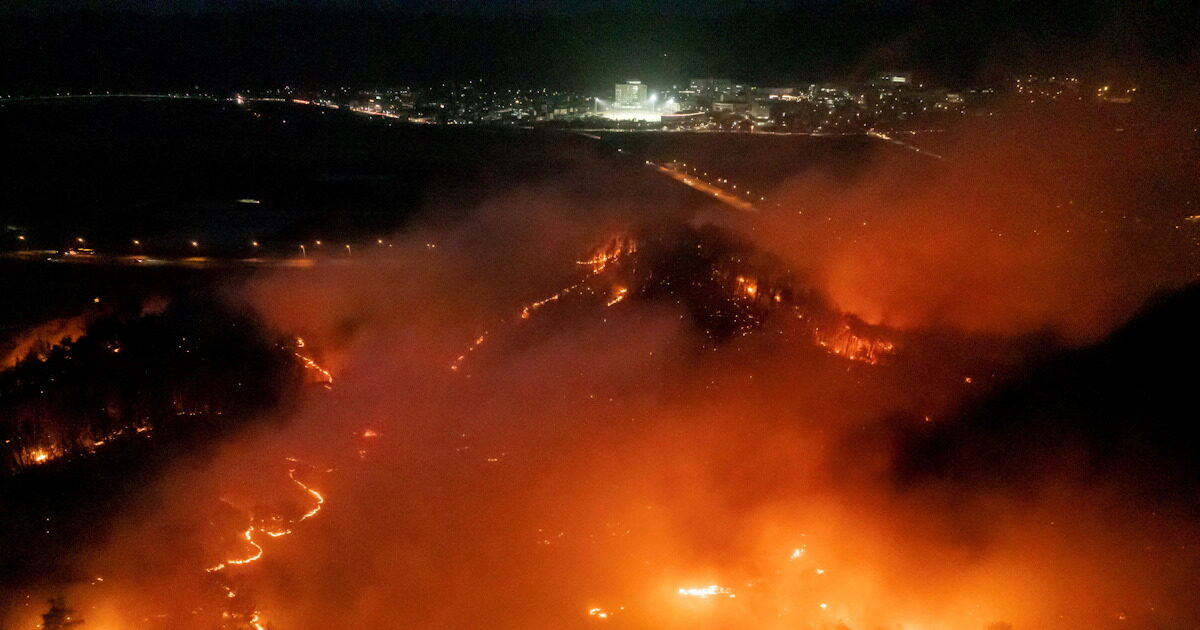Unmistakable tragedy in South Koreawith at least 24 people losing their lives to forest fires raging from the weekend, the worst recorded in the country for decades that have caused unprecedented damage.
‘So far it has been confirmed The death of 24 people from fires and 12 are still seriously injured »he said an interior ministry official in southern Korea, explaining that they were “temporary numbers”.
Earlier today, Wednesday (26.03.25) a helicopter involved in extinguishing operations in the southeast of South Korea “Currently crashed into a mountainous area of Useong County”, The Fire Department of Gieongbuk province has announced.
The helicopter pilot, who was killed in the crash, is included in the report of the dead by the authorities.
At least 16 people have died in wildfires across South Korea as of March 25, 2025.
A massive fire that started in Uiseong, North Gyeongsang Province, has been spreading for four days, reaching Andong, Cheongsong, Juwangsan National Park, Yeongyang, and Yeongdeok.
The… pic.twitter.com/2PfbUdhwu6
—The Informant (@theinformant_x) March 25, 2025
Following this incident, the Korean Forest Service announced that All the helicopters of the helicopter closes to the ground.
The forest service fleet, consisting of 48 Russian helicopters, faces technical problems. Eight is out of service last year as the South Korean authorities cannot import spare parts from Russia due to sanctions imposed on Ukraine’s invasion, Yun Zun-Baeong, a Democratic Party MP in October, had explained.
BREAKING: At least 12 people killed in South Korea wildfires pic.twitter.com/puHqubrCHM
— BNO News (@BNONews) March 25, 2025
From the weekend, Thousands of firefighters fight to extinguish more than 10 forest fires which have already destroyed thousands of acres.
These fires “have caused unprecedented damage,” said the country’s transitional President Han Duki, stressing that “They are evolving in a way that transcends existing predictions.”
Han today increased the alarm level today and announced “a comprehensive national answer”.
These fires, exacerbated by dry conditions and winds, forced authorities to proceed The removal of almost 23,000 people from their homes, including thousands of prisoners in prison.
1000 year old Temple consumed by wildfire
Thousand-year-old Unramsa Temple on Cheondeungsan Mountain South Korea, was completely destroyed by a forest fire yesterday. It quickly spread due to strong winds, burning down both the main building and its outbuildings.
“Before the… pic.twitter.com/X5Bk6aTjUy
— Volcaholic (@volcaholic1) March 23, 2025
South Korean authorities issued an emergency warning of historian residents Tuesday night Hahaoe village. This particularly tourist part, included in the UNESCO World Heritage List, It was still threatened today by flames.
More than 170,000 acres of forest have been burned, Han pointed out, referring to a “critical” situation. It is a greater extent than the 160,000 acres who had been burned in January in the devastating fires of Los Angeles.
To deal with fires have also mobilized hundredsaccording to the South Korean service president.
These soldiers are added to most of 6.700 firefighters developed, Two -fifths of which are located in the Uyenong area.
South Korea on fire: horrific fires engulf the country, evacuating about 1.5 thousand people
A total of 27 fires have been recorded in the country, with the 6 regions.
I will never believe that such many fires occurred naturally. pic.twitter.com/wWQDvhSo66— Gennady Simanovsky (@GennadySimanovs) March 23, 2025
Rising temperatures, increase in fuel and decrease in rainfall are among the factors associated with climate change and which appear to have favored the spread of forest fires.
“The area had an abnormally dry weather, with rainfall smaller than average,” Han Duk-SO revealed, while stressing that this year twice as many fires have erupted in the southern part of the country compared to 2024.
Last year was the warmest ever recorded in South Korea, with the annual average temperature reaching 14.5 ° C, two degrees above the average of 30 years, according to the Korean meteorological service.
